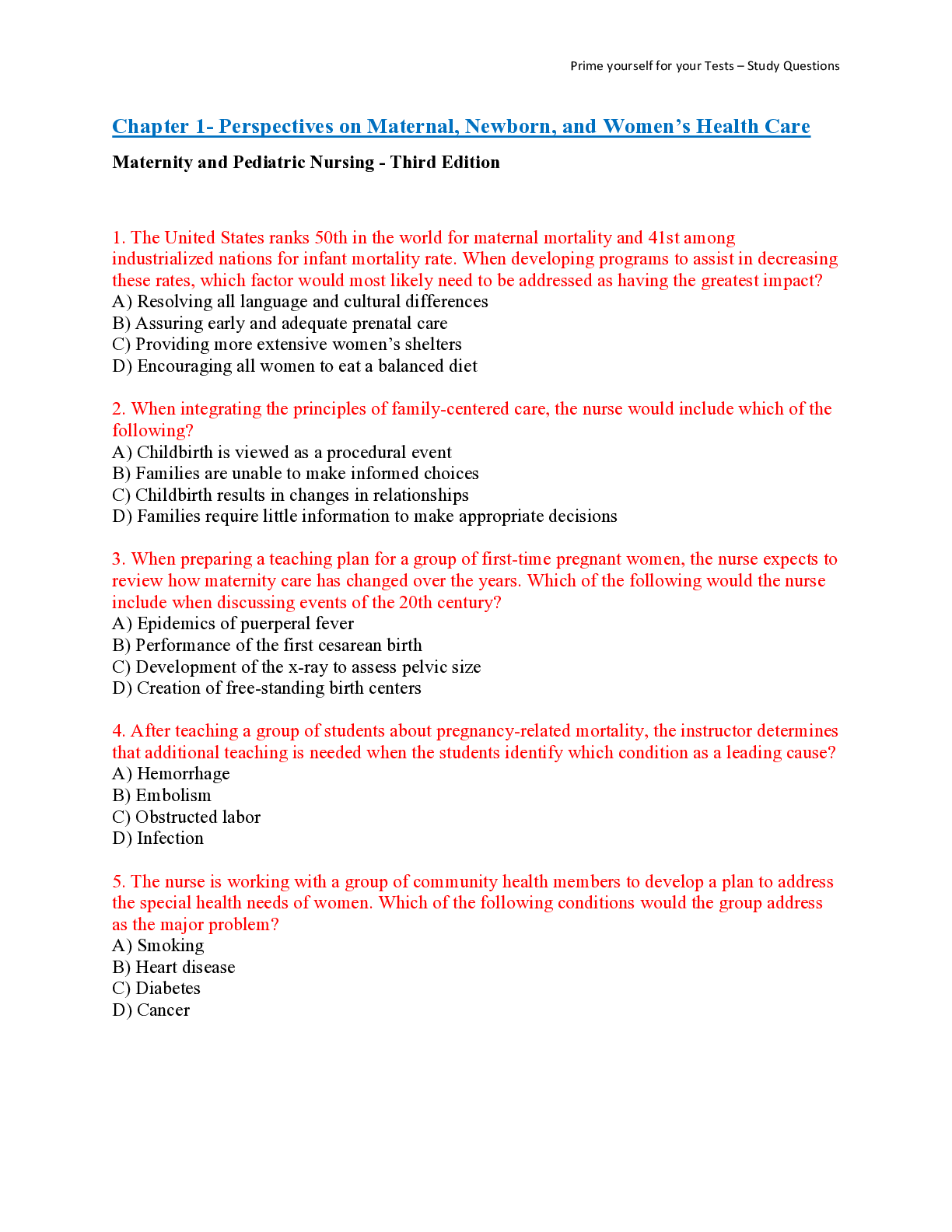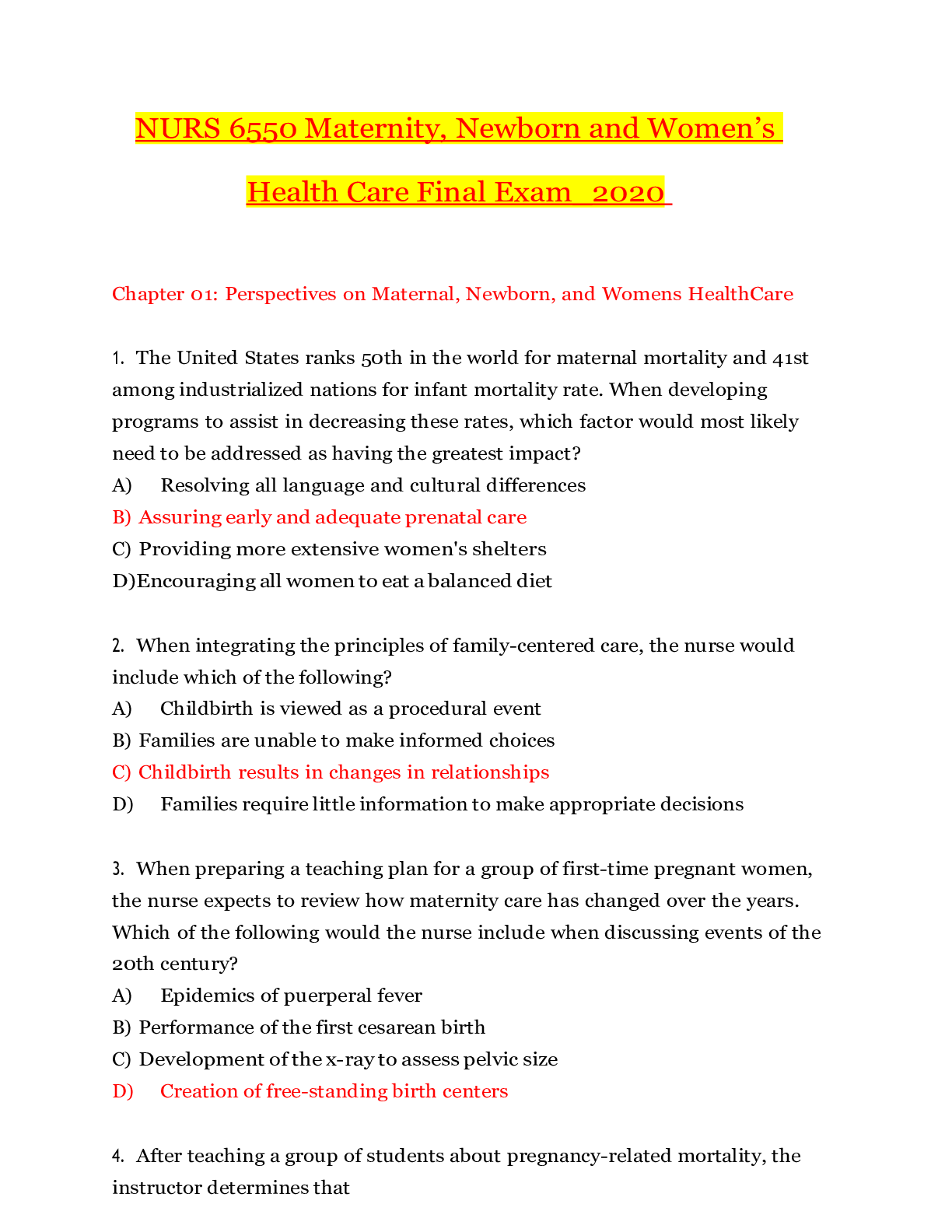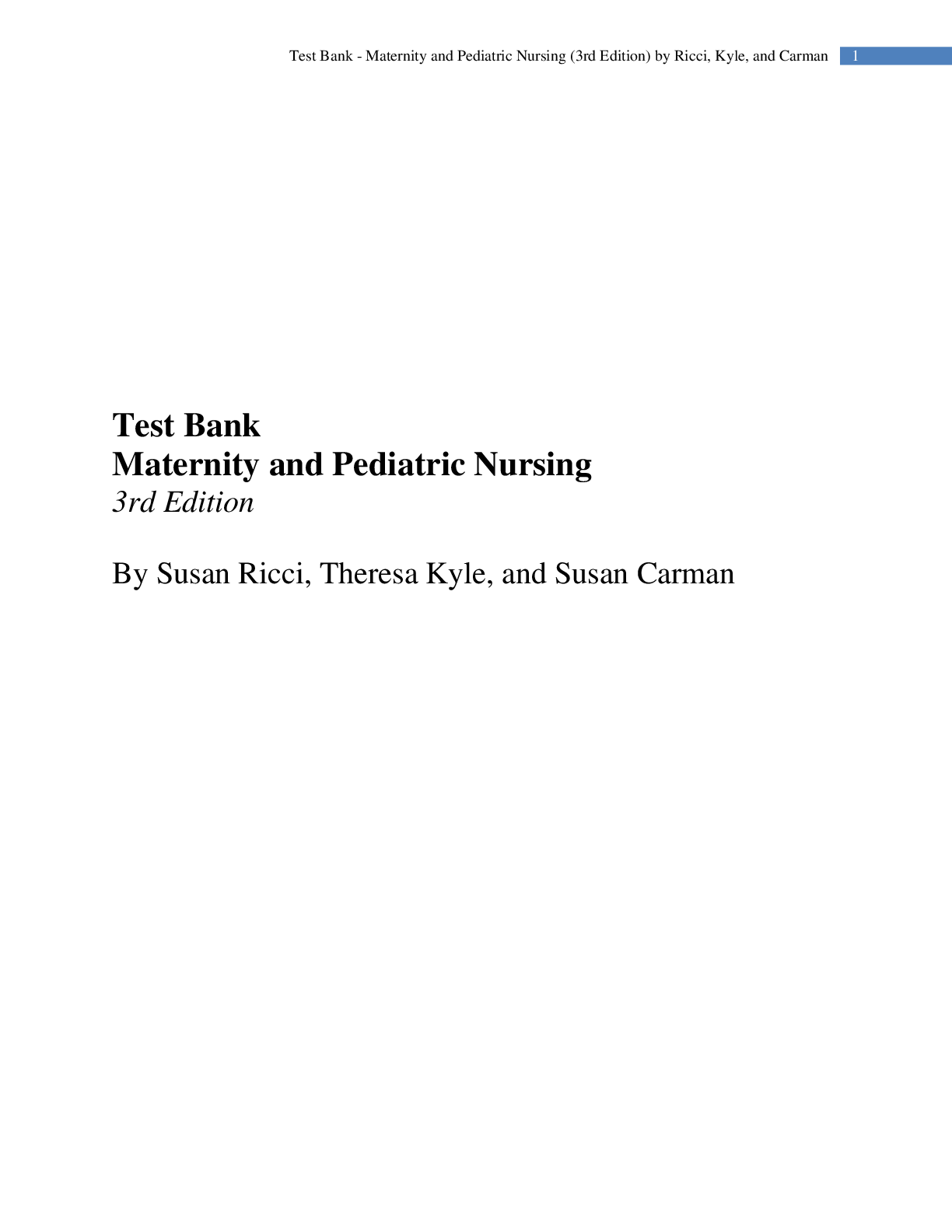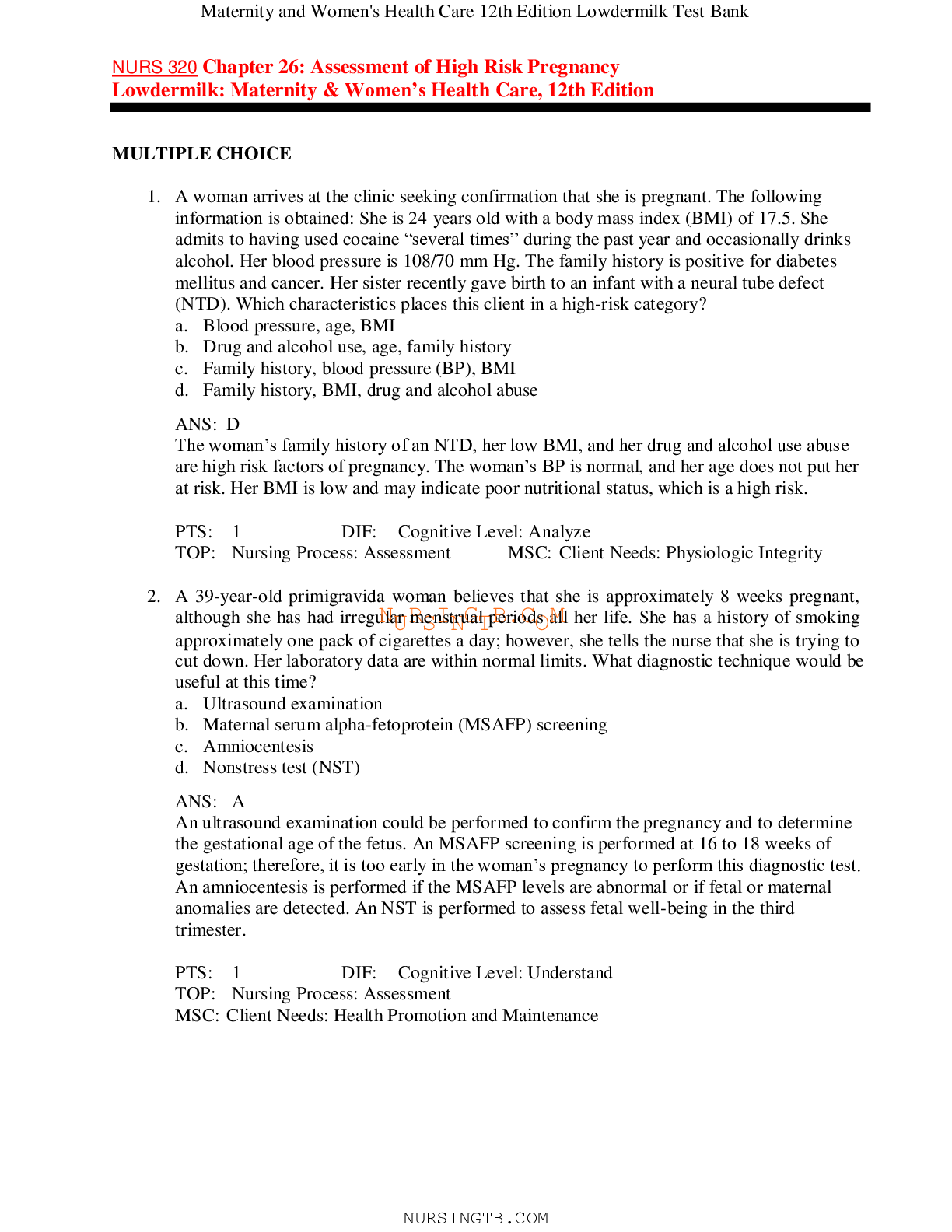*NURSING > EXAM > NUR 300 WI Maternity & Women’s Health Care 12th Edition (2019/2020) - Chapter 29 – Central Michi (All)
NUR 300 WI Maternity & Women’s Health Care 12th Edition (2019/2020) - Chapter 29 – Central Michigan University | Endocrine and Metabolic Disorders
Document Content and Description Below
NUR 300 WI Maternity & Women’s Health Care 12th Edition - Chapter 29 – Central Michigan University Chapter 29: Endocrine and Metabolic Disorders MULTIPLE CHOICE 1. Preconception counsel... ing is critical in the safe management of diabetic pregnancies. Which complication is commonly associated with poor glycemic control before and during early pregnancy? a. Frequent episodes of maternal hypoglycemia b. Congenital anomalies in the fetus c. Hydramnios d. Hyperemesis gravidarum Preconception counseling is particularly important since strict metabolic control before conception and in the early weeks of gestation is instrumental in decreasing the risk of congenital anomalies. Frequent episodes of maternal hypoglycemia may occur during the first trimester (not before conception) as a result of hormonal changes and the effects on insulin production and use. Hydramnios occurs approximately 10 times more often in diabetic pregnancies than in nondiabetic pregnancies. Typically, it is observed in the third trimester of pregnancy. Hyperemesis gravidarum may exacerbate hypoglycemic events because the decreased food intake by the mother and glucose transfer to the fetus contribute to hypoglycemia. DIF: Cognitive Level: Understand REF: IM: 687 TOP: Nursing Process: Planning MSC: Client Needs: Physiologic Integrity 2. During a prenatal visit, the nurse is explaining dietary management to a woman with pregestational diabetes. Which statement by the client reassures the nurse that teaching has been effective? a. I will need to eat 600 more calories per day because I am pregnant. b. I can continue with the same diet as before pregnancy as long as it is well balanced. c. Diet and insulin needs change during pregnancy. d. I will plan my diet based on the results of urine glucose testing. Diet and insulin needs change during the pregnancy in direct correlation to hormonal changes and energy needs. In the third trimester, insulin needs may double or even quadruple. The diet is individualized to allow for increased fetal and metabolic requirements, with consideration of such factors as prepregnancy weight and dietary habits, overall health, ethnic background, lifestyle, stage of pregnancy, knowledge of nutrition, and insulin therapy. Energy needs are usually calculated on the basis of 30 to 35 calories per kilogram of ideal body weight. Dietary management during a diabetic pregnancy must be based on blood, not urine, glucose changes. DIF: Cognitive Level: Analyze REF: IM: 689 TOP: Nursing Process: Evaluation MSC: Client Needs: Physiologic Integrity 3. Screening at 24 weeks of gestation reveals that a pregnant woman has gestational diabetes mellitus (GDM). In planning her care, the nurse and the client mutually agree that an expected outcome is to prevent injury to the fetus as a result of GDM. This fetus is at the greatest risk for which condition? a. Macrosomia b. Congenital anomalies of the central nervous system c. Preterm birth d. Low birth weight Poor glycemic control later in pregnancy increases the rate of fetal macrosomia. Poor glycemic control during the preconception time frame and into the early weeks of the pregnancy is associated with congenital anomalies. Preterm labor or birth is more likely to occur with severe diabetes and is the greatest risk in women with pregestational diabetes. Increased weight, or macrosomia, is the greatest risk factor for this fetus. DIF: Cognitive Level: Understand REF: IM: 690 TOP: Nursing Process: Planning | Nursing Process: Implementation MSC: Client Needs: Physiologic Integrity 4. A 26-year-old primigravida has come to the clinic for her regular prenatal visit at 12 weeks. She appears thin and somewhat nervous. She reports that she eats a well-balanced diet, although her weight is 5 pounds less than it was at her last visit. The results of laboratory studies confirm that she has a hyperthyroid condition. Based on the available data, the nurse formulates a plan of care. Which nursing diagnosis is most appropriate for the client at this time? a. Deficient fluid volume b. Imbalanced nutrition: less than body requirements c. Imbalanced nutrition: more than body requirements d. Disturbed sleep pattern This clients clinical cues include weight loss, which supports a nursing diagnosis of Imbalanced nutrition: less than body requirements. No clinical signs or symptoms support a nursing diagnosis of deficient fluid volume. This client reports weight loss, not weight gain. Although the client reports nervousness, the most appropriate nursing diagnosis, based on the clients other clinical symptoms, is Imbalanced nutrition: less than body requirements. DIF: Cognitive Level: Analyze REF: IM: 706 TOP: Nursing Process: Diagnosis MSC: Client Needs: Physiologic Integrity 5. A client with maternal phenylketonuria (PKU) has come to the obstetrical clinic to begin prenatal care. Why would this preexisting condition result in the need for closer monitoring during pregnancy? a. PKU is a recognized cause of preterm labor. b. The fetus may develop neurologic problems. c. A pregnant woman is more likely to die without strict dietary control. d. Women with PKU are usually mentally handicapped and should not reproduce. Children born to women with untreated PKU are more likely to be born with mental retardation, microcephaly, congenital heart disease, and low birth weight. Maternal PKU has no effect on labor. Women without dietary control of PKU are more likely to miscarry or bear a child with congenital anomalies. Screening for undiagnosed maternal PKU at the first prenatal visit may be warranted, especially in individuals with a family history of the disorder, with low intelligence of an uncertain cause, or who have given birth to microcephalic infants. DIF: Cognitive Level: Understand REF: IM: 707 TOP: Nursing Process: Assessment MSC: Client Needs: Physiologic Integrity 6. The nurse who is caring for a woman hospitalized for hyperemesis gravidarum would expect the initial treatment to involve what? a. Corticosteroids to reduce inflammation b. Intravenous (IV) therapy to correct fluid and electrolyte imbalances c. Antiemetic medication, such as pyridoxine, to control nausea and vomiting d. Enteral nutrition to correct nutritional deficits Initially, the woman who is unable to down clear liquids by mouth requires IV therapy to correct fluid and electrolyte imbalances. Corticosteroids have been successfully used to treat refractory hyperemesis gravidarum, but they are not the expected initial treatment for this disorder. Pyridoxine is vitamin B6, not an antiemetic medication. Promethazine, a common antiemetic, may be prescribed. In severe cases of hyperemesis gravidarum, enteral nutrition via a feeding tube may be necessary to correct maternal nutritional deprivation but is not the initial treatment for this client. DIF: Cognitive Level: Apply REF: IM: 705 TOP: Nursing Process: Implementation MSC: Client Needs: Physiologic Integrity 7. In terms of the incidence and classification of diabetes, which information should the nurse keep in mind when evaluating clients during their ongoing prenatal appointments? a. Type 1 diabetes is most common. b. Type 2 diabetes often goes undiagnosed. c. GDM means that the woman will receive insulin treatment until 6 weeks after birth. d. Type 1 diabetes may become type 2 during pregnancy. Type 2 diabetes often goes undiagnosed because hyperglycemia gradually develops and is often not severe. Type 2, sometimes called adult-onset diabetes, is the most common type of diabetes. GDM refers to any degree of glucose intolerance first recognized during pregnancy; insulin may or may not be needed. People do not go back and forth between type 1 and type 2 diabetes. DIF: Cognitive Level: Apply REF: IM: 688 TOP: Nursing Process: Assessment MSC: Client Needs: Physiologic Integrity 8. A number of metabolic changes occur throughout pregnancy. Which physiologic adaptation of pregnancy will influence the nurses plan of care? a. Insulin crosses the placenta to the fetus only in the first trimester, after which the fetus secretes its own. b. Women with insulin-dependent diabetes are prone to hyperglycemia during the first trimester because they are consuming more sugar. c. During the second and third trimesters, pregnancy exerts a diabetogenic effect that ensures an abundant supply of glucose for the fetus. d. Maternal insulin requirements steadily decline during pregnancy. Pregnant women develop increased insulin resistance during the second and third trimesters. Insulin never crosses the placenta; the fetus starts making its own around the 10th week. As a result of normal metabolic changes during pregnancy, insulin-dependent women are prone to hypoglycemia (low levels). Maternal insulin requirements may double or quadruple by the end of pregnancy. DIF: Cognitive Level: Understand REF: IM: 689 TOP: Nursing Process: Planning MSC: Client Needs: Physiologic Integrity 9. Which statement concerning the complication of maternal diabetes is the most accurate? a. Diabetic ketoacidosis (DKA) can lead to fetal death at any time during pregnancy. b. Hydramnios occurs approximately twice as often in diabetic pregnancies than in nondiabetic pregnancies. c. Infections occur about as often and are considered about as serious in both diabetic and nondiabetic pregnancies. d. Even mild-to-moderate hypoglycemic episodes can have significant effects on fetal well-being. Prompt treatment of DKA is necessary to save the fetus and the mother. Hydramnios occurs 10 times more often in diabetic pregnancies. Infections are more common and more serious in pregnant women with diabetes. Mild-to-moderate hypoglycemic episodes do not appear to have significant effects on fetal well-being. DIF: Cognitive Level: Understand REF: IM: 691 TOP: Nursing Process: Planning MSC: Client Needs: Physiologic Integrity 10. Which statement regarding the laboratory test for glycosylated hemoglobin Alc is correct? a. The laboratory test for glycosylated hemoglobin Alc is performed for all pregnant women, not only those with or likely to have diabetes. b. This laboratory test is a snapshot of glucose control at the moment. c. This laboratory test measures the levels of hemoglobin Alc, which should remain at less than 7%. d. This laboratory test is performed on the womans urine, not her blood. Hemoglobin Alc levels greater than 7% indicate an elevated glucose level during the previous 4 to 6 weeks. This extra laboratory test is for diabetic women and defines glycemic control over the previous 4 to 6 weeks. Glycosylated hemoglobin level tests are performed on the blood. DIF: Cognitive Level: Understand REF: IM: 692 TOP: Nursing Process: Evaluation MSC: Client Needs: Health Promotion and Maintenance 11. A new mother with a thyroid disorder has come for a lactation follow-up appointment. Which thyroid disorder is a contraindication for breastfeeding? a. Hyperthyroidism b. PKU c. Hypothyroidism d. Thyroid storm PKU is a cause of mental retardation in infants; mothers with PKU pass on phenylalanine and therefore should elect not to breastfeed. A woman with either hyperthyroidism or hypothyroidism would have no particular reason not to breastfeed. A thyroid storm is a complication of hyperthyroidism and is not a contraindication to breastfeeding. DIF: Cognitive Level: Understand REF: IM: 708 TOP: Nursing Process: Planning MSC: Client Needs: Physiologic Integrity 12. An 18-year-old client who has reached 16 weeks of gestation was recently diagnosed with pregestational diabetes. She attends her centering appointment accompanied by one of her girlfriends. This young woman appears more concerned about how her pregnancy will affect her social life than her recent diagnosis of diabetes. A number of nursing diagnoses are applicable to assist in planning adequate care. What is the most appropriate diagnosis at this time? a. Risk for injury, to the fetus related to birth trauma b. Deficient knowledge, related to diabetic pregnancy management c. Deficient knowledge, related to insulin administration d. Risk for injury, to the mother related to hypoglycemia or hyperglycemia Before a treatment plan is developed or goals for the outcome of care are outlined, this client must come to an understanding of diabetes and the potential effects on her pregnancy. She appears more concerned about changes to her social life than adopting a new self-care regimen. Risk for injury to the fetus related to either placental insufficiency or birth trauma may come later in the pregnancy. At this time, the client is having difficulty acknowledging the adjustments that she needs to make to her lifestyle to care for herself during pregnancy. The client may not yet be on insulin. Insulin requirements increase with gestation. The importance of glycemic control must be part of health teaching for this client. However, she has not yet acknowledged that changes to her lifestyle need to be made and may not participate in the plan of care until understanding takes place. DIF: Cognitive Level: Analyze REF: IM: 693 TOP: Nursing Process: Diagnosis MSC: Client Needs: Psychosocial Integrity - - - - - - - - - - - - - - - - - - - - - - TOP: Nursing Process: Assessment MSC: Client Needs: Physiologic Integrity 17. To manage her diabetes appropriately and to ensure a good fetal outcome, how would the pregnant woman with diabetes alter her diet? a. Eat six small equal meals per day. b. Reduce the carbohydrates in her diet. c. Eat her meals and snacks on a fixed schedule. d. Increase her consumption of protein. Having a fixed meal schedule will provide the woman and the fetus with a steady blood sugar level, provide a good balance with insulin administration, and help prevent complications. Having a fixed meal schedule is more important than the equal division of food intake. Approximately 45% of the food eaten should be in the form of carbohydrates. DIF: Cognitive Level: Understand REF: IM: 693 TOP: Nursing Process: Planning MSC: Client Needs: Health Promotion and Maintenance [Show More]
Last updated: 1 year ago
Preview 1 out of 20 pages
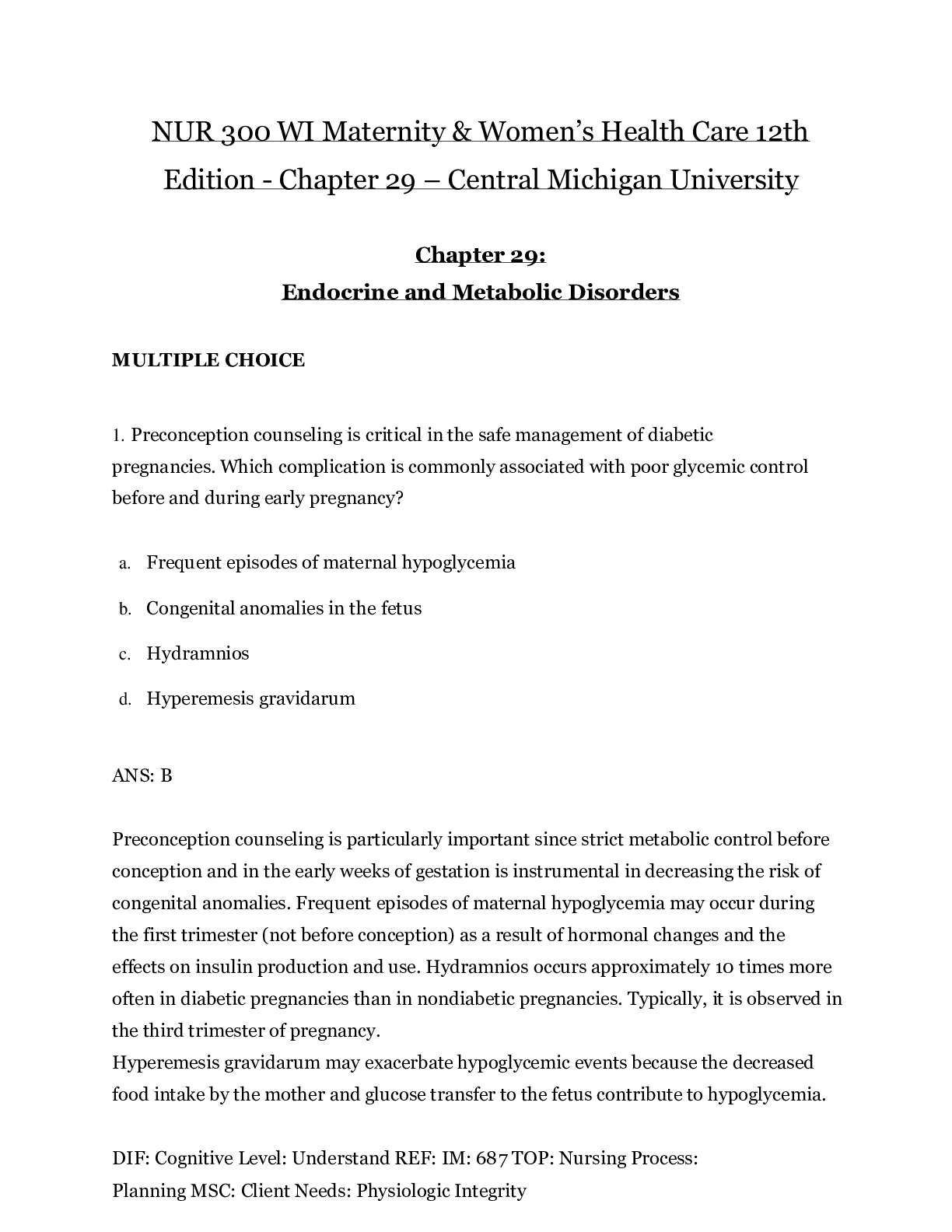
Reviews( 0 )
Document information
Connected school, study & course
About the document
Uploaded On
Jun 29, 2020
Number of pages
20
Written in
Additional information
This document has been written for:
Uploaded
Jun 29, 2020
Downloads
0
Views
48


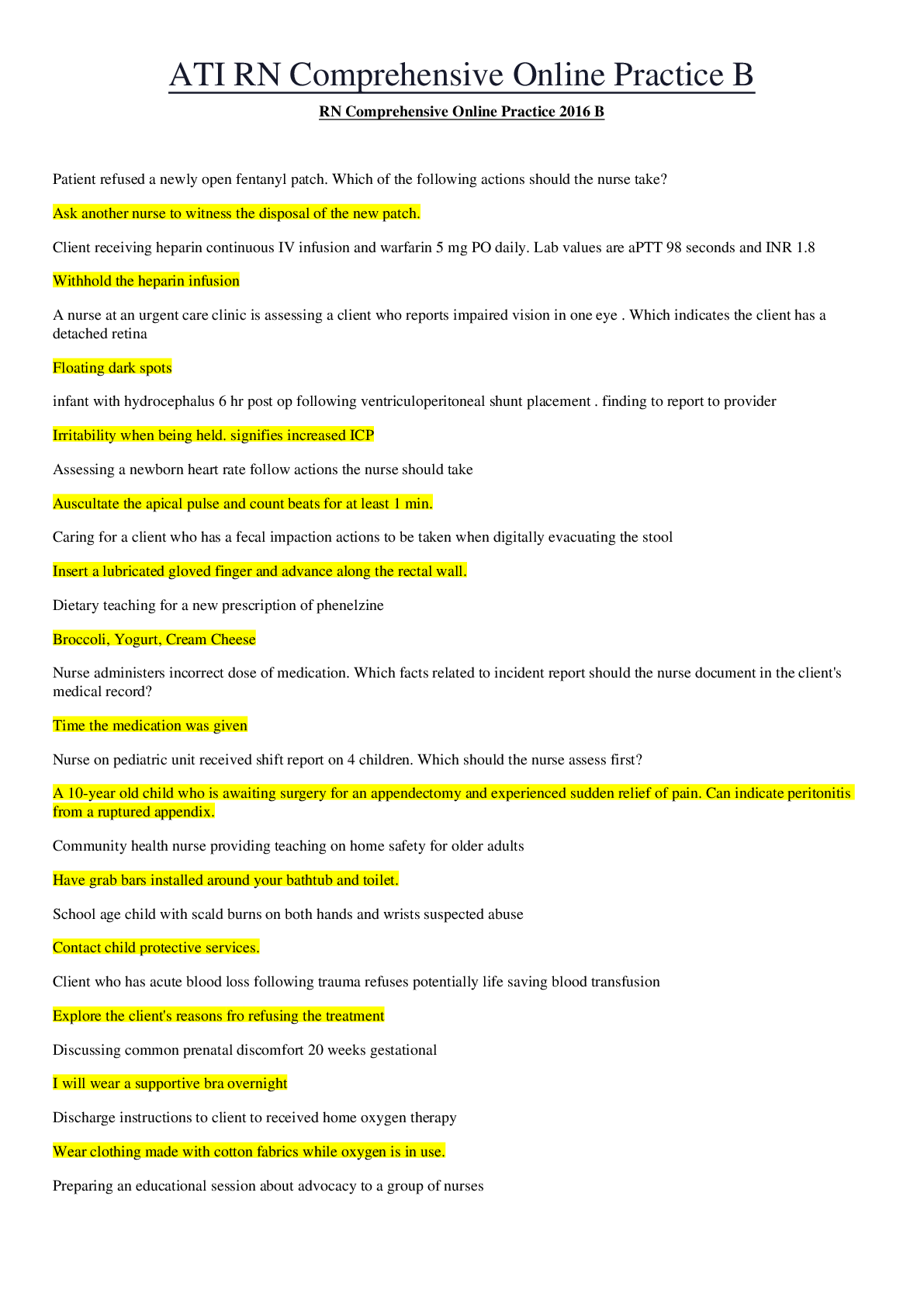
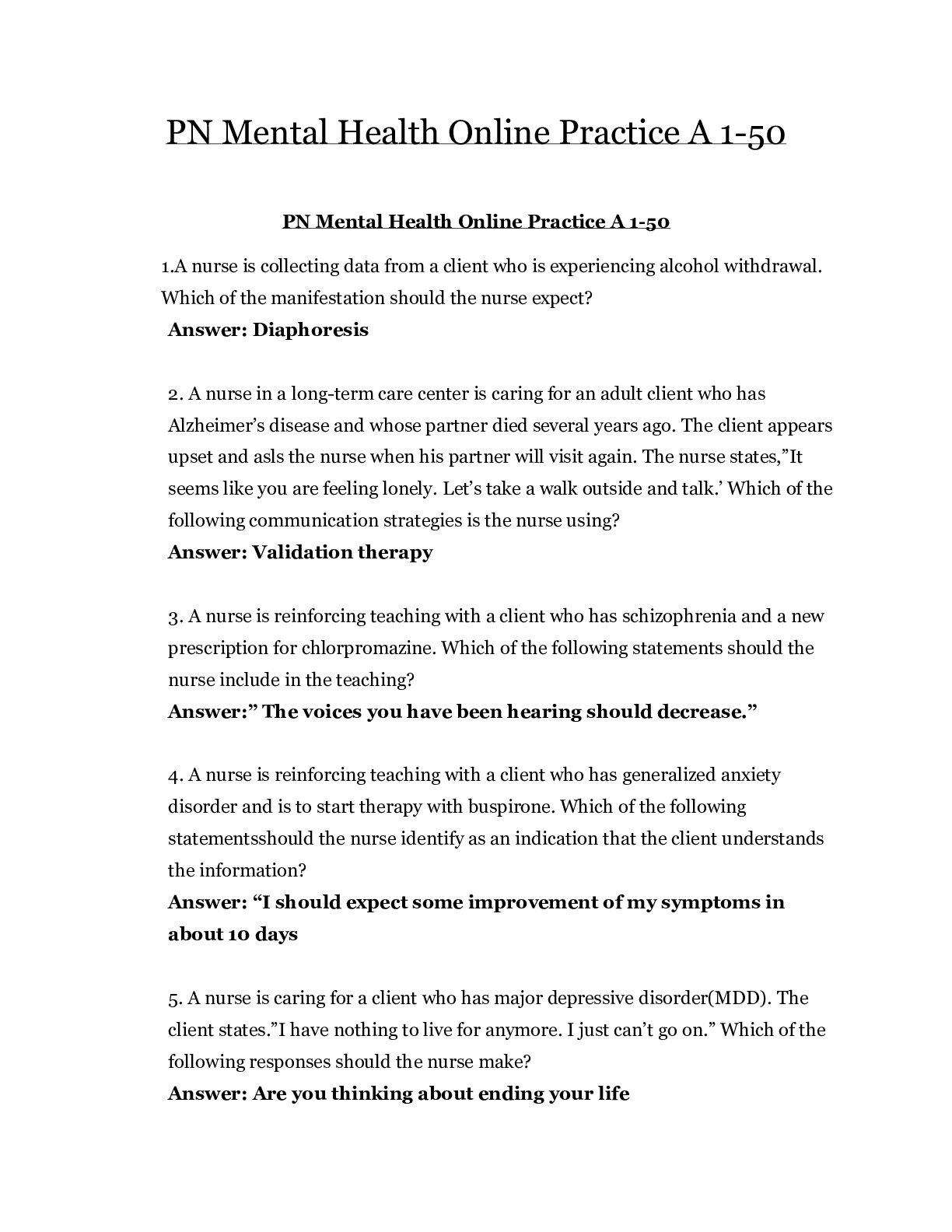
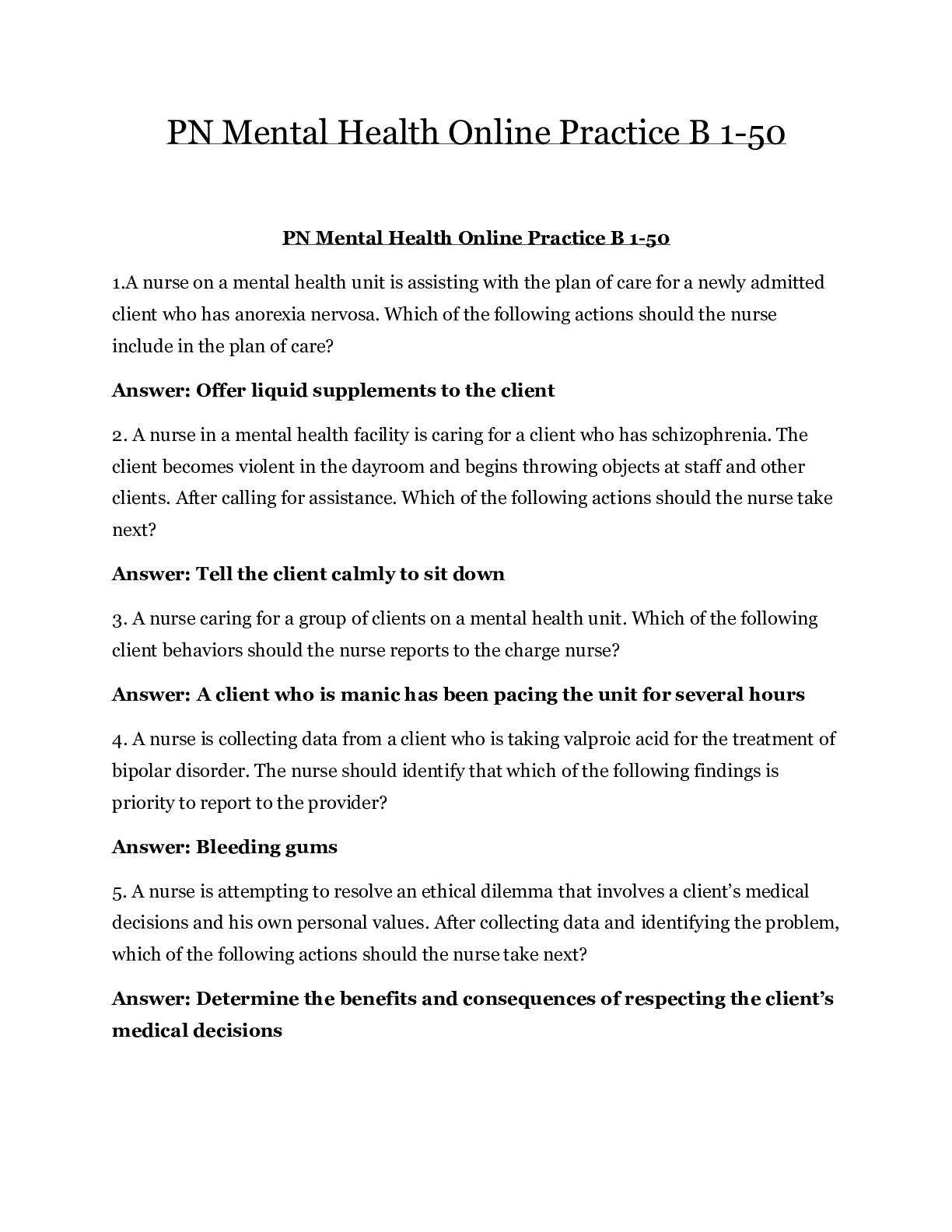
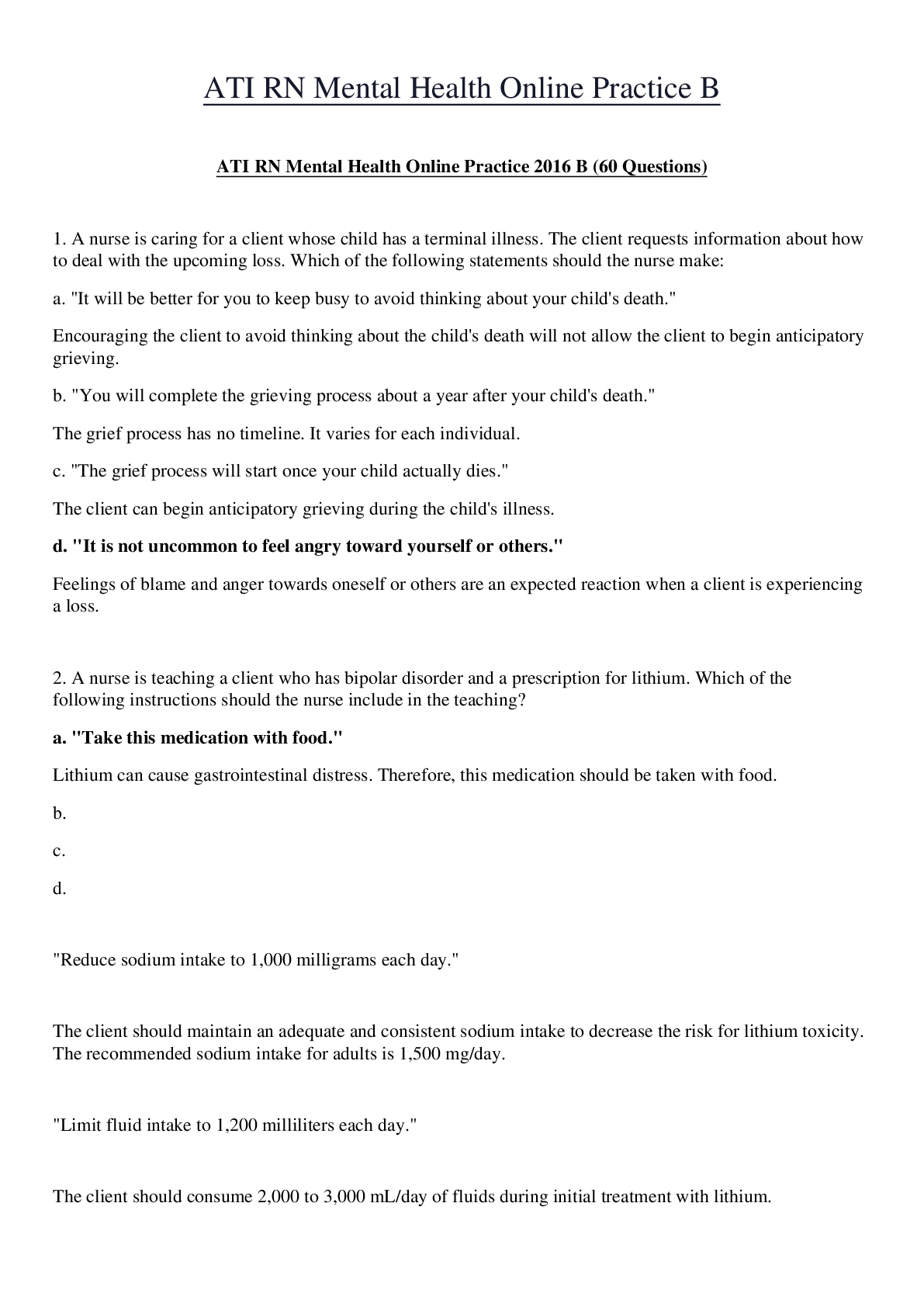


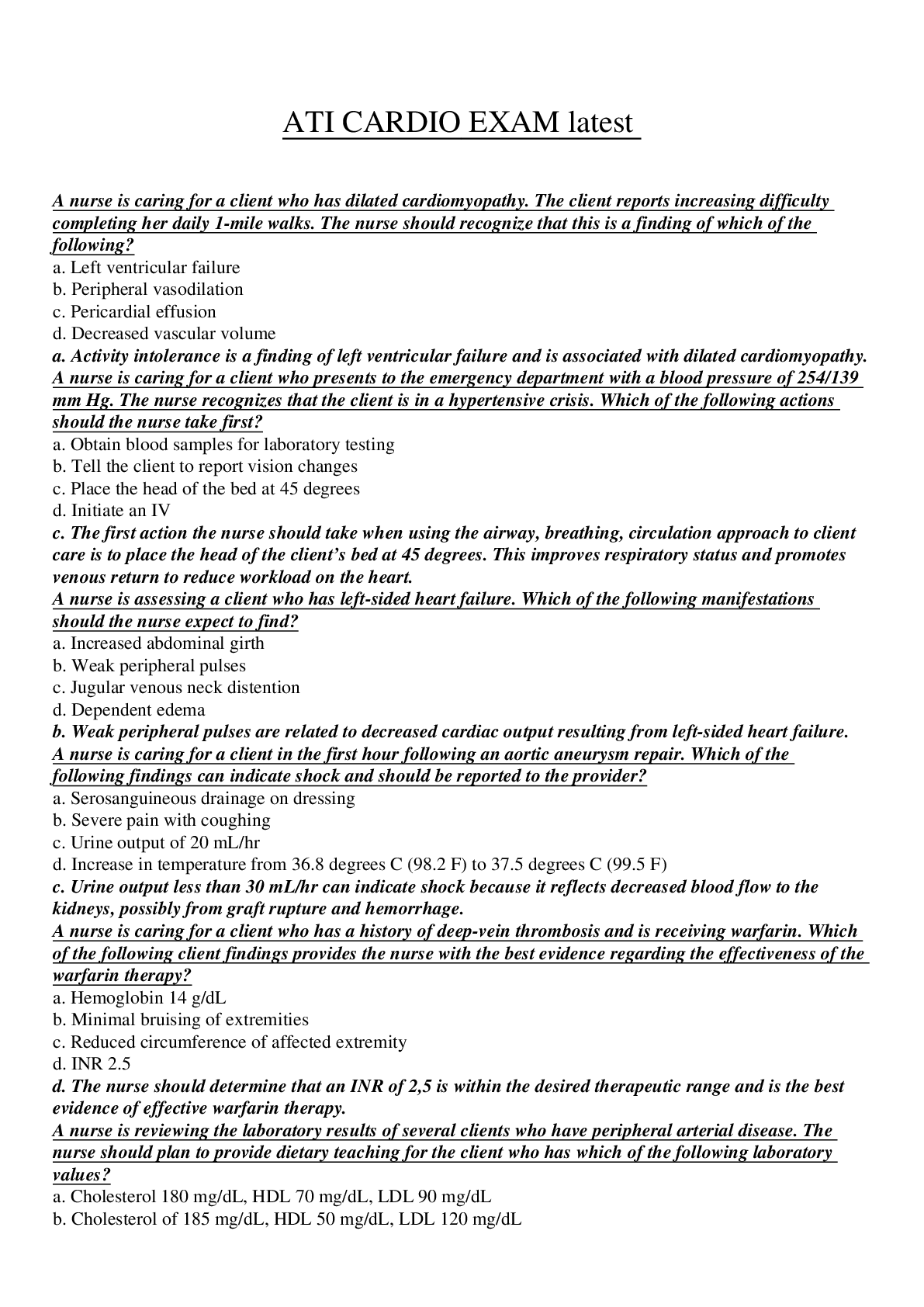
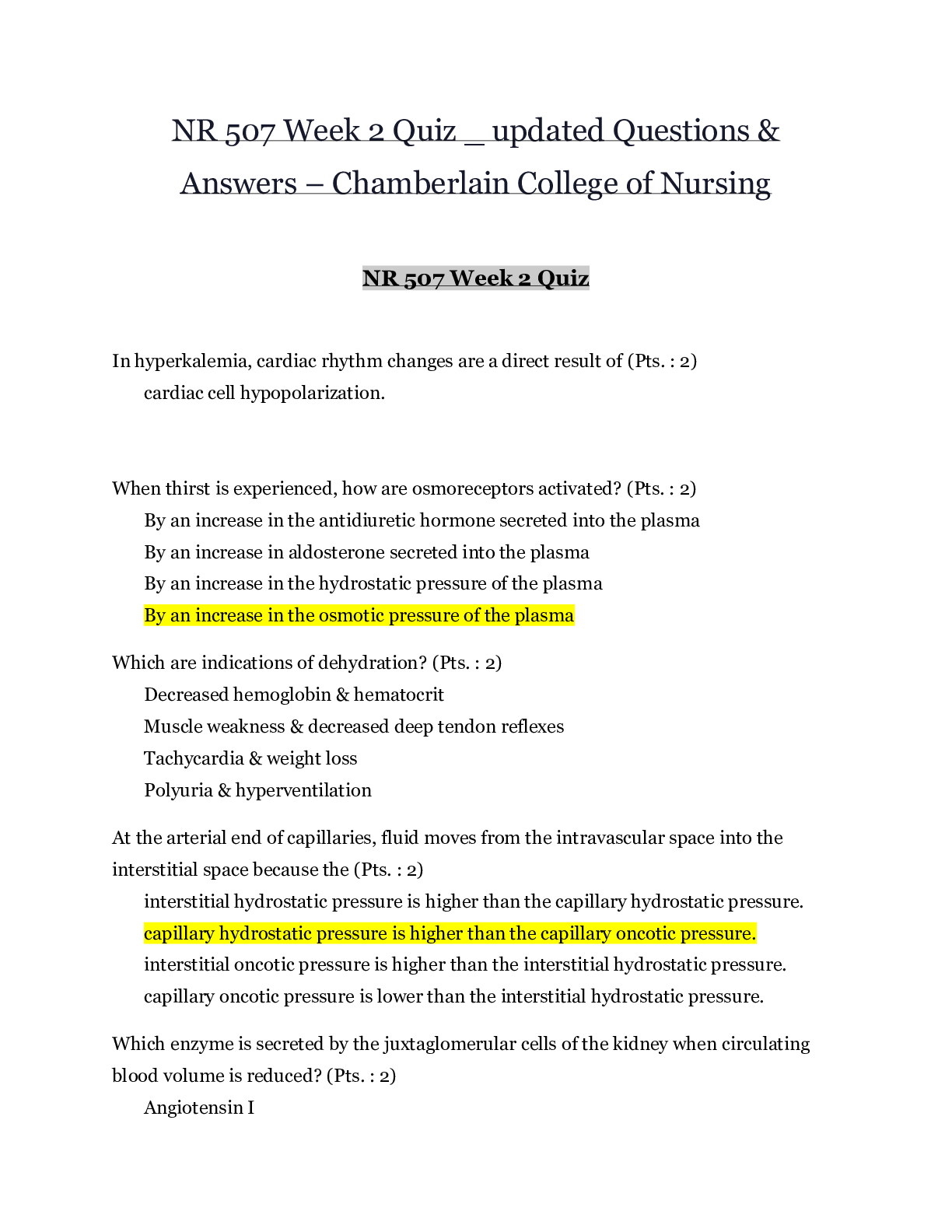
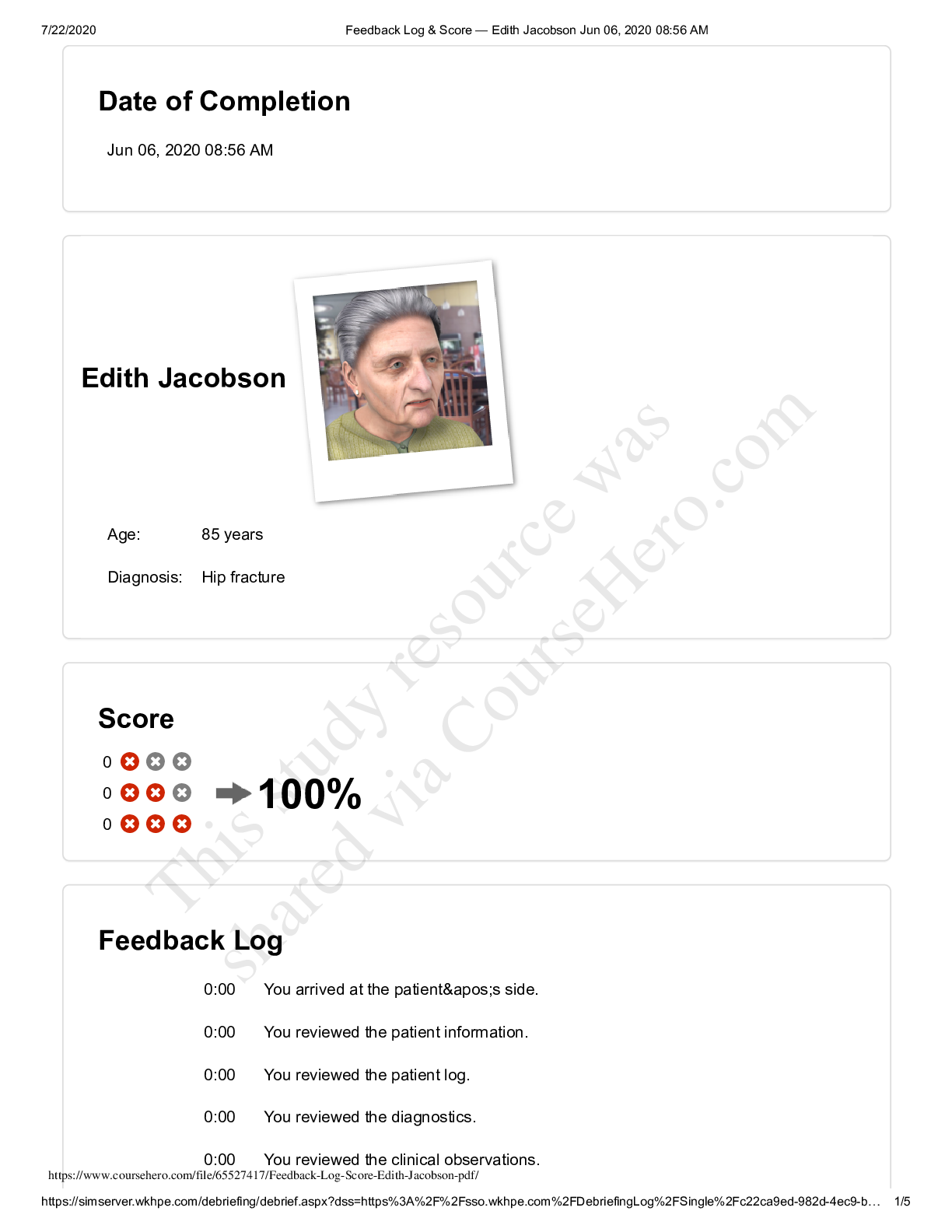
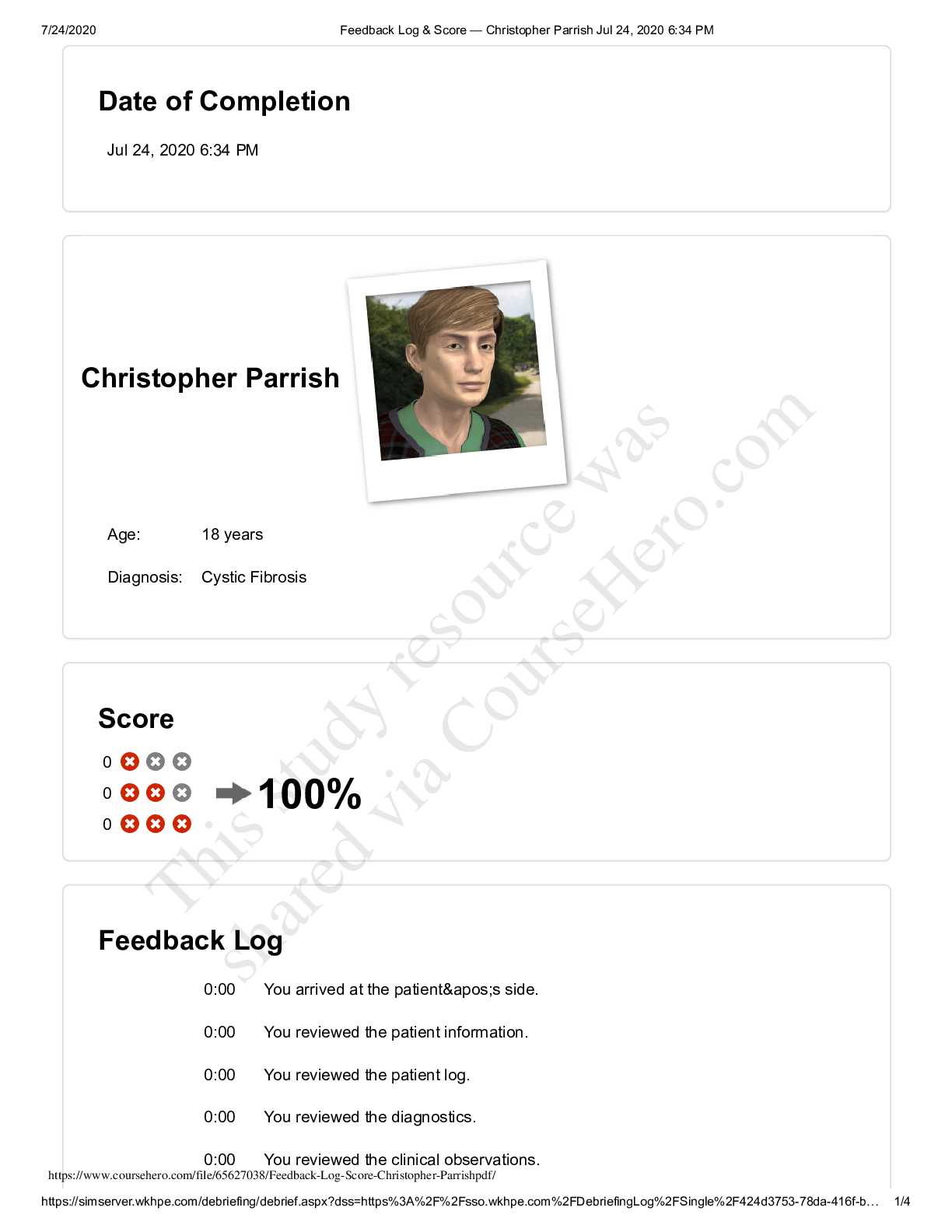
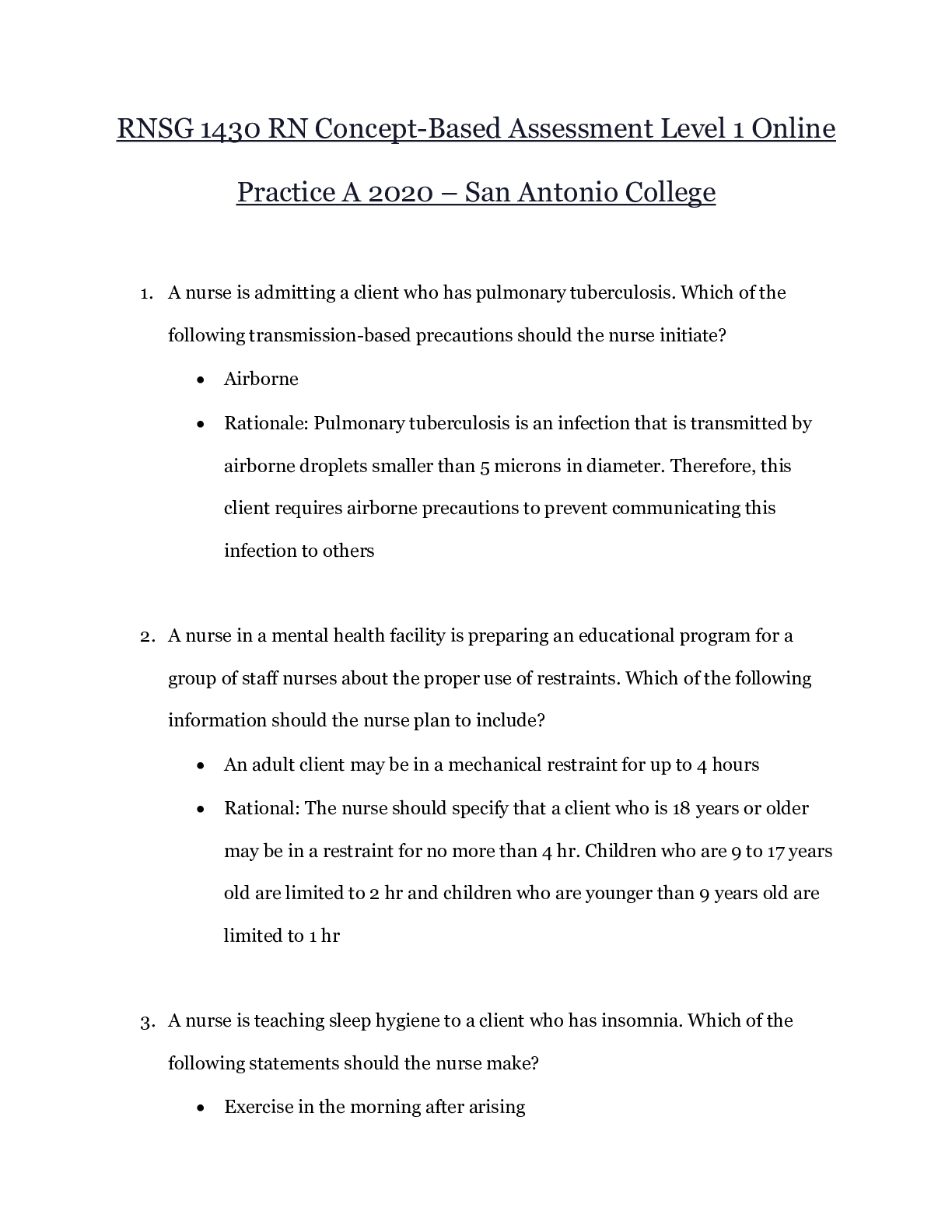


 – CHAMBERLAIN COLLEGE OF NURSING.png)
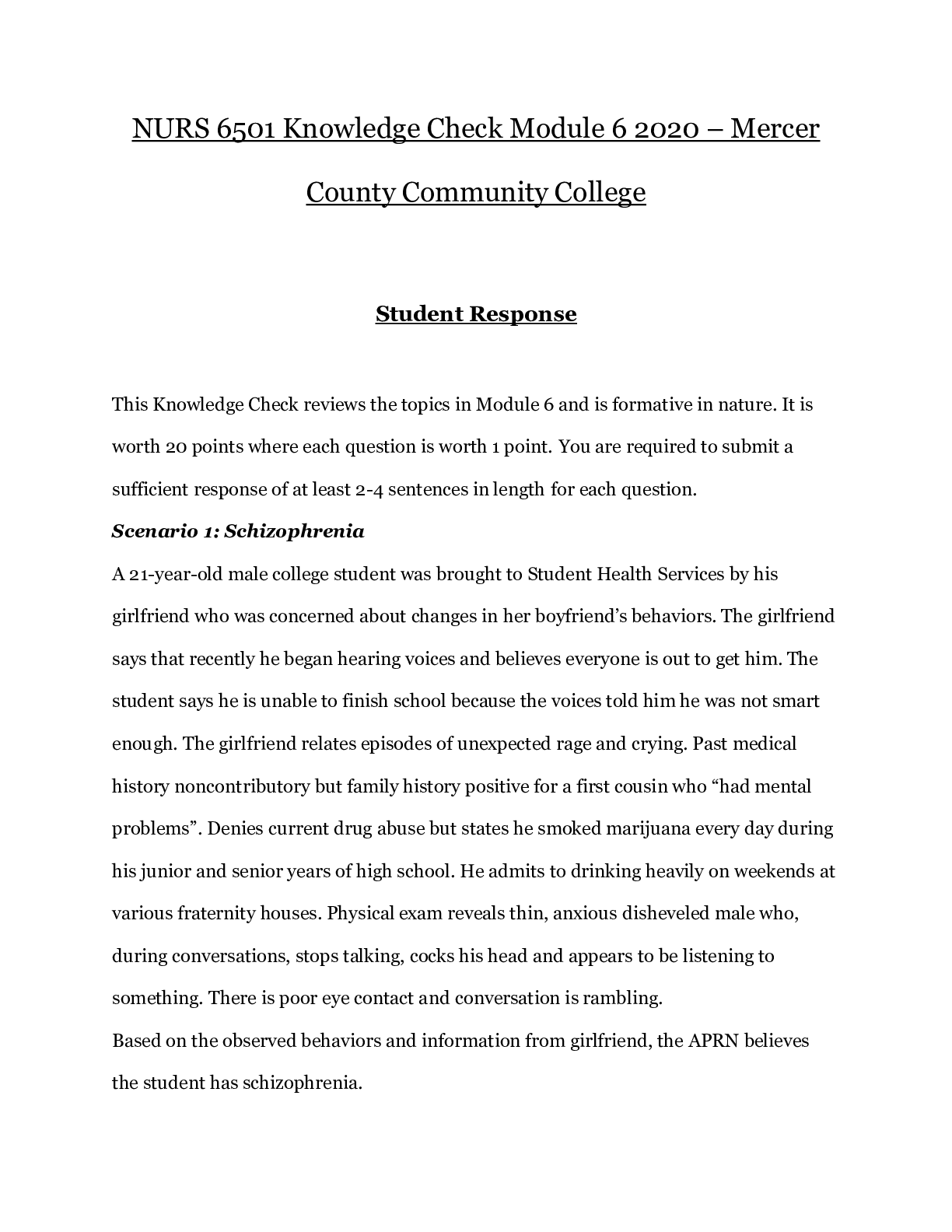
Test Bank Latest 2023.png)



